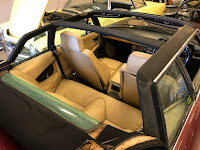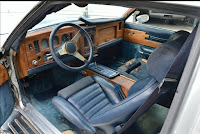About a year ago, just as I made the somewhat painful decision to sell my 1977 Corvette, a neighbor of ours had a 1990 Jaguar XJ-S convertible for sale just like this one and I had to take it for a spin. I had absolutely zero interest in buying it but, you never know. Maybe I'd be so enthralled with it I'd do the necessary mental gymnastics to convince myself to cut a check, or cheque for it. Besides, after living with the '77 Corvettes for years and everything it put me through, how bad could one of these be? Thus, wife in tow, off we went. Top down and all.
If you're of a certain vintage, you may have swooned over these dreamboats. I know I did. Growing up on Long Island's South Shore, to me, nothing embodied unobtainable levels of class, sophistication, refinement and success more than any Jaguar, in particular the 1975-1996 XJ-S and even more so, the XJ-S "dropheads". Drophead? Oh, sorry. That's what the Britt-Tisch refer to as convertibles.
Built on a shortened wheelbase chassis of their XJ sedan and with some tuning to the suspension to make it seem more sporting, Jaguar introduced the XJ-S in 1975 to, technically at least, replace the ancient and old-timey looking E-Type that had been around since 1961. More of a luxury grand touring car than sports car like the E-Type, while a hit with buyers, critics damned the XJ-S with faint praise not so much for what it was, but for what it wasn't. That being it was not an E-Type.
Available only as a hard top at first, Jaguar came out with a semi-fixed roof, canvassed-topped, targa-like "convertible" in 1983 they called the XJS-C. Above is a 1983. Reminds me of food in Great Britain. Not only is it weird looking, but its taste can also be revolting. I'd leave the top up. All the time.
After much huffing, fussing, buttressing and expensive reengineering, Jaguar finally did right by us XJ-S fans when they came out with a, please clench your jaws when you say this, lovey, "proper convertible" in 1988. What a looker it was too. So, when a neighbor had, ostensibly an "open house" on theirs, I jumped at the chance to live life like someone from the North Shore.
Now, granted, I knew it wouldn't come up to the clandestine driving experience I've had on racetracks in in a NASCAR stock car and Ferrari 488, but I expected it to at least ride, handle and accelerate with the aplomb of a fourth-generation Corvette. Long story short, it didn't.
The big V-12 turned over reluctantly coughing, hacking and belching like my mother used to before her first Pall Mall in the morning. "She's got to warm up!" my neighbor noted as she saw the concern in my face. Once it did, I found the engine to have far less pop in its bat than my '77 Corvette's engine did. The steering was sloppy, the suspension janky banging thunderously over the impossibly bad roads of our town. The car had only 36,000-miles on it but the struts or shocks or springs needed to be sorted out. At least the transmission shifted imperceptibly. Well, of course it did. It was a General Motors Turbo 400.
While we felt like rock stars in it, when I asked my wife if she wanted to drive it, I mean, how many times in your life will you get to drive a Jaguar XJ-S convertible? She sensed my ambivalence if not disappointment and begged off the opportunity.
Back at the ranch, I handed the keys to my neighbor noting the engine's sluggishness and rough suspension. The car had a general feeling of delicateness to it too, make that expensively delicate. She said it had been her late father's car, and they had had a number of challenges with it over the years. Electrical gremlins, mostly. Also, problems with the fuel injection and the air conditioning was constantly on the fritz. Repairs were expensive and it was hard to find someone to work on it and shops they did find that could, had a wait list sometimes three-months long. If not longer. She was asking around $12,000 for it - I don't know if I would have paid half that for it.
Sigh. Just another case of, "don't meet your idols".















































